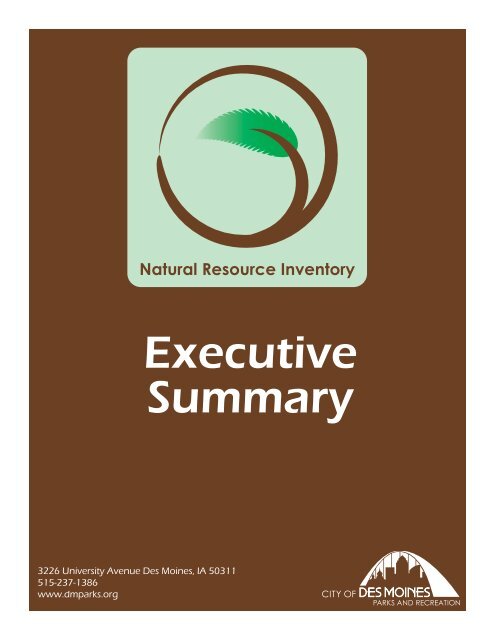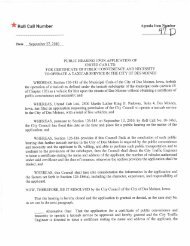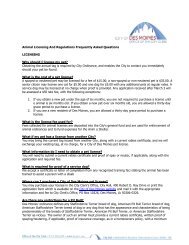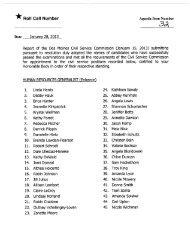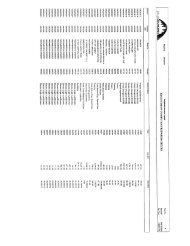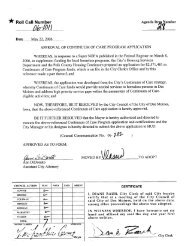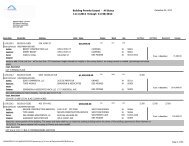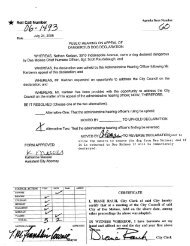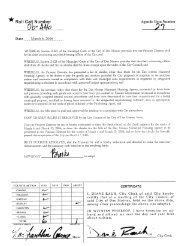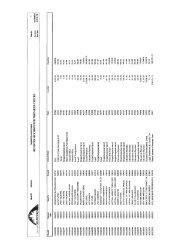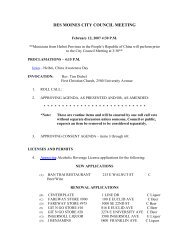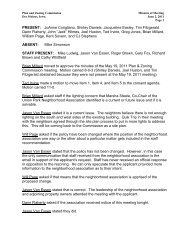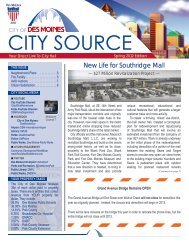Executive Summary - City of Des Moines
Executive Summary - City of Des Moines
Executive Summary - City of Des Moines
You also want an ePaper? Increase the reach of your titles
YUMPU automatically turns print PDFs into web optimized ePapers that Google loves.
Natural Resource Inventory<br />
<strong>Executive</strong><br />
<strong>Summary</strong><br />
3226 University Avenue <strong>Des</strong> <strong>Moines</strong>, IA 50311<br />
515-237-1386<br />
www.dmparks.org<br />
PARKS AND RECREATION
NATURAL RESOURCES INVENTORY OF THE<br />
CITY OF DES MOINES PARKS AND<br />
CONSERVATION LAND<br />
Report to:<br />
<strong>City</strong> <strong>of</strong> <strong>Des</strong> <strong>Moines</strong> Parks and Recreation Department<br />
3226 University Avenue, <strong>Des</strong> <strong>Moines</strong>, IA 50311<br />
By:<br />
Dr. Thomas Rosburg<br />
Department <strong>of</strong> Biology, Drake University<br />
2507 University Avenue, <strong>Des</strong> <strong>Moines</strong>, IA 50311<br />
Or<br />
Botanical and Ecological Consulting<br />
73448 260 th St, Colo, IA 50056<br />
May 2013
EXECUTIVE SUMMARY<br />
The principal results <strong>of</strong> the natural resource inventory <strong>of</strong> the <strong>Des</strong> <strong>Moines</strong> park system are<br />
summarized here. There are several central conclusions that can be made.<br />
1) The conservation value and importance <strong>of</strong> the park system is demonstrated by the presence <strong>of</strong> an<br />
impressive number <strong>of</strong> vascular plant species; the number <strong>of</strong> plant species supported is very high. The<br />
651 species observed includes 459 that are native to central Iowa, which represents 30% <strong>of</strong> the native<br />
flora <strong>of</strong> Iowa. In other words, nearly one third <strong>of</strong> the state's native plants inhabit the park system's<br />
ecosystems. The 459 native species observed exceed the number <strong>of</strong> native plant species that have been<br />
observed in the floristic surveys for several Iowa counties (much larger areas). It also exceeds the<br />
number <strong>of</strong> native species observed in a similar study at Whiterock Conservancy in Guthrie County (a<br />
similar amount <strong>of</strong> land area). The number <strong>of</strong> native and naturalized species observed in the park system<br />
is 617, a measure <strong>of</strong> floral richness that exceeds the richness observed in Ledges State Park in a study<br />
done in 1985. Ledges State Park occupies about one fourth <strong>of</strong> the land area as the <strong>Des</strong> <strong>Moines</strong> park<br />
system, but it is considered to be one <strong>of</strong> the state's botanical jewels due to its topographic and edaphic<br />
diversity.<br />
Obviously many <strong>of</strong> these native plant species are common species that occur throughout Iowa.<br />
Nonetheless, the high plant richness observed verifies the park system is providing important<br />
conservation results ~ high plant richness helps to support high animal richness. A sensible approach to<br />
conservation is summed up by the phrase "a goal <strong>of</strong> conservation should be to keep the common species<br />
common". The high plant richness <strong>of</strong> the park system informs the park system <strong>of</strong> a paramount<br />
responsibility - management should sustain and protect this high plant diversity.<br />
2) The quality <strong>of</strong> the flora supported by the park system is substantial. This can be supported by three<br />
types <strong>of</strong> evidence. First, there were 8 species observed that are endangered, threatened, or special<br />
concern species in Iowa. One <strong>of</strong> these, the threatened species shining willow, is a tentative identification<br />
and needs further investigation to verify identification. The<br />
3 | page
other 7 species are listed as special concern species; 4 <strong>of</strong> them are especially notable in their importance.<br />
Two <strong>of</strong> the four species (pale violet and frost grape) represent the first known observations for the<br />
species in Polk County. The other two species (long-scaled green sedge and large seed dodder)<br />
represent just the second observation for Polk County. It is clear that the park system is providing<br />
habitat for several uncommon plant species in central Iowa.<br />
The second line <strong>of</strong> support for the significant quality <strong>of</strong> the flora is based on the conservatism <strong>of</strong> plant<br />
species. The 459 native species observed include 78 (17.0%) that have an Iowa Coefficient <strong>of</strong><br />
Conservatism <strong>of</strong> 7, 8, 9 or 10 (10 is the maximum coefficient). The range <strong>of</strong> 7-10 is used to indicate a high<br />
level <strong>of</strong> conservatism, which means the species is conservative in its habitat requirements and therefore<br />
mainly inhabits pristine and natural environments. Plant conservatism provides a way to distinguish<br />
weedy, early successional, common species (low conservatism) from species that are more specialized,<br />
infrequent, and dependent on later successional natural habitats. Relatively high numbers (or percentage)<br />
<strong>of</strong> high conservative species indicate a higher ecosystem quality. Although the 17% <strong>of</strong> high conservatism<br />
species in the park system is somewhat lower than some other sites chosen for comparison, those other<br />
sites (e.g., Sylvan Runkel State Preserve with 23% and Whiterock Conservancy with 19%) are among<br />
some <strong>of</strong> the highest quality botanical sites in Iowa, and they do not have a history <strong>of</strong> urbanization and<br />
human disturbance. Given the urban environment <strong>of</strong> the <strong>Des</strong> <strong>Moines</strong> park system, the conservatism<br />
observed is a positive feature that indicates high quality ecosystems are present.<br />
The third source <strong>of</strong> evidence for substantial floristic quality is the occurrence <strong>of</strong> new records for native<br />
plant species in Iowa. There were 6 species observed that are not included on the current checklist <strong>of</strong><br />
Iowa plants. One <strong>of</strong> these, spreading sand mat, is a new record for Iowa. Three <strong>of</strong> the species are new<br />
records for Polk County. The absence <strong>of</strong> the other two species from the checklist can be explained by<br />
different nomenclatural interpretations. Overall, these new records provide additional evidence <strong>of</strong> the<br />
<strong>Des</strong> <strong>Moines</strong> park system supporting unusual and important plant species.<br />
4 | Page
3) Much <strong>of</strong> the park systems conservation value comes from the diversity <strong>of</strong> ecosystems that are<br />
supported, which are identified by the plant associations that were delineated and mapped. There are 80<br />
natural or semi-natural plant associations supported by park system and they account for about 53.6% <strong>of</strong><br />
the total area (the remaining acreage is parkland, the term used to reference the highly managed areas in<br />
the park, water, and non-vegetation areas). Among these natural plant associations, 21 are<br />
herbaceous/grassland types, 4 are shrubland types, 2 are savanna types, 11 are woodland types, 23 are<br />
forest types and 19 are wetland types. Among the natural/semi-natural associations, forest associations<br />
account for the greatest area (64.6%), followed by herbaceous associations (22.8%), woodlands (6.0%)<br />
and wetlands (5.8%).<br />
Oak-dominated associations account for 14% <strong>of</strong> all forests and woodlands in the park system. They also<br />
represent the extant communities that have the highest remnant value and potential for ecological<br />
restoration. For the most part, they represent highly degraded oak savanna and oak woodland, which are<br />
two native plant associations that were originally a large part <strong>of</strong> the native landscape in central Iowa, but<br />
nowadays are essentially gone from the landscape due to decades <strong>of</strong> woody encroachment and urban<br />
development. The <strong>Des</strong> <strong>Moines</strong> Park system is in a unique and significant position in that it can make an<br />
important contribution to the restoration <strong>of</strong> oak savanna and oak woodland through renovation <strong>of</strong> these<br />
degraded remnants. Oak savanna and woodland restoration is possible in several parks, including<br />
MacRae, Pioneer, Prospect, Grandview, Ewing, Greenwood, Ashworth and Waveland Golf Course.<br />
Tallgrass prairie reconstruction and cool season grass-forb associations account for 38% <strong>of</strong> the area <strong>of</strong> the<br />
herbaceous communities. Although additional tallgrass reconstruction could be done by utilizing the cool<br />
season grass-forb communities (which are dominated by non-native grasses), it is important to consider<br />
the landscape and habitat diversity created by maintaining some <strong>of</strong> the park lands in cool season grass<br />
associations. The increased landscape diversity that comes from greater numbers <strong>of</strong> different plant<br />
associations within a park provides higher habitat diversity and heterogeneity that translates into higher<br />
wildlife value. There certainly could be more tallgrass prairie reconstruction accomplished in the park<br />
system. Prairie occupied the second largest share <strong>of</strong> the native landscape <strong>of</strong> the park system (35.3%), but<br />
now<br />
5 | page
only represents 1.2% <strong>of</strong> the park system. There is ample cool season grass parkland, which has very low<br />
wildlife value, that could be utilized for prairie reconstruction. In converting it to tallgrass prairie, not<br />
only is there more native vegetation and wildlife habitat (which increases the park's value for wildlife<br />
viewing, photography, nature observation, environmental education), there is less mowing maintenance<br />
to do once the prairie is established. Any new prairie reconstructions should utilize a seed mix that is<br />
entirely comprised <strong>of</strong> species native to central Iowa. Three prairie species have been planted in the parks<br />
that are not native to central Iowa, two in an ecosystem restoration (wild quinine and purple coneflower),<br />
one in a prairie garden (prairie smoke) and one in lawn (buffalo grass).<br />
There is also good opportunity to accomplish wetland restoration in the park system. Although wetlands<br />
comprise a very small part <strong>of</strong> the park's ecosystems, they support an inordinately large number <strong>of</strong> plants.<br />
Nearly a third (31. 7%) <strong>of</strong> the plant species observed have a wetland affinity <strong>of</strong>-2 or lower (occur in<br />
wetlands 67% or more <strong>of</strong> the time), and nearly a fifth (18.9%) have a wetland affinity <strong>of</strong> -4 or lower<br />
(occur in wetlands 89% or more <strong>of</strong> the time). Among the 78 high conservative species observed, 25<br />
(32.1%) are wetland species (wetland affinity ≤ -2). Wetlands not only increase the botanical diversity<br />
and quality <strong>of</strong> the park system, but they also increase the function <strong>of</strong> the park system in providing<br />
essential ecosystem services like cleansing water <strong>of</strong> sediment and nutrients, controlling flooding, storing<br />
carbon and replenishing groundwater.<br />
4) The most critical management task needed in the park system is invasive species control. The<br />
integrity <strong>of</strong> the entire park system, its ability to provide habitat for native organisms, recreational<br />
experiences for users, and sustainable ecosystem services is compromised by the threat <strong>of</strong> invasive plant<br />
species. It is imperative that the <strong>Des</strong> <strong>Moines</strong> park system take an aggressive approach to controlling<br />
invasive species. Every tract <strong>of</strong> park land has an invasive species problem. Among the 180 non-native<br />
species encountered in the park system, 45 could be labeled invasive (approximately 25%). The<br />
invasive species with the highest potential for causing loss <strong>of</strong> biodiversity include:<br />
• Ailanthus altissima (Tree <strong>of</strong> heaven)<br />
6 | page
• Alliaria petialata (garlic mustard)<br />
• Berberis thunbergii (Japanese barberry)<br />
• Bromus inermis (smooth brome)<br />
• Celastrus orbiculotus (oriental bittersweet)<br />
• Cirsium arvense (Canada thistle)<br />
• Conium maculatum (poison hemlock)<br />
• Caronilla varia (crown vetch) .<br />
• Elaeagnus species (Russian and autumn olive)<br />
• Lespedeza cuneata (sericea lespedeza)<br />
• Lonicera species (Honeysuckle species)<br />
• Morus alba (white mulberry)<br />
• Pastinaca sativa (wild parsnip)<br />
• Phalaris arundinacea (reed canary grass)<br />
• Polygonum cuspidatum (Japanese bamboo)<br />
• Populus alba (white popular)<br />
• Rhamnus cathartica (common or European buckthorn)<br />
• Robinia pseudoacacia (black locust)<br />
• Rosa multiflora (multiflora rose)<br />
• Trifolium species (red and alsike clover)<br />
Pollution is also an important threat to park biodiversity and function. The most conspicuous form <strong>of</strong><br />
pollution observed is the illegal dumping <strong>of</strong> many kinds <strong>of</strong> discarded items. Many parks have degraded<br />
habitats due to dumping. In some cases it appears to be <strong>of</strong> recent origin and in other cases it appears to be<br />
historic. Some <strong>of</strong> the most blatant examples were observed at McHenry, Prospect, Greenwood, Gray's<br />
Lake and in the North <strong>Des</strong> <strong>Moines</strong> River Open Space along Morningstar Drive. Water pollution, evident<br />
from very discolored water, is present in the stream along Morningstar Drive.<br />
5) Three species <strong>of</strong> ash trees are present in the park system - green ash, white ash and black ash. All<br />
are susceptible to the emerald ash borer. Green ash is a ubiquitous species on park<br />
7 | page
lands. It was the most abundant species in the plant inventory <strong>of</strong> the extant plant associations identified<br />
and delineated. It was also the most abundant species in the tree mapping survey that was done on much<br />
<strong>of</strong> the parkland habitat in the park system. Its presence throughout many <strong>of</strong> the ecosystems on park lands<br />
suggests that its demise (due to the borer) could cause a substantial ecological disturbance. White and<br />
black ash are much less abundant than green ash. White ash occurs in a few parklands where it has been<br />
planted and as a natural member <strong>of</strong> several plant communities. Black ash is less common than white ash<br />
and only present as a natural member <strong>of</strong> a few plant communities. The low occurrence <strong>of</strong> both white and<br />
black ash means that their loss from parks and natural areas is not likely to be devastating as green ash.<br />
However, both white and black ash are more conservative than green ash, so their removal may have<br />
important unknown effects.<br />
6) Ecosystem restoration should be a priority for park management. Oak woodlands and savanna should<br />
be the first priority since they were historically very important but nowadays are among the most<br />
threatened <strong>of</strong> ecosystems. They are also the only ecosystem present in the park system that occurs as a<br />
remnant, albeit very degraded. Mac Rae, Greenwood, Prospect and Pioneer <strong>of</strong>fer opportunities for oak<br />
woodland and savanna restoration. Prairie reconstruction should be the second highest priority, and the<br />
goal <strong>of</strong> placing a prairie example in every park is doable. Parkland and cool season grass habitats occur<br />
in nearly every park site, and they provide a good starting point for reconstruction. It is important to<br />
design seed mixes that are appropriate for Polk County (paying attention to species biogeography) and<br />
for the habitat (paying attention to ecology). Wetland reconstruction is the third priority, since there are<br />
fewer good sites and the logistics <strong>of</strong> wetland reconstruction are usually more difficult than prairie.<br />
Identifying a site for a wetland reconstruction is the first important step and an understanding <strong>of</strong> the site's<br />
hydrology is imperative. One site that appears to have potentially good sites is Cownie Soccer Open<br />
Space, especially for wetlands that would support wetland wildlife.<br />
Another important strategy that this ecosystem inventory can support is a policy <strong>of</strong> best-use<br />
management. Basically this means that each park or unit <strong>of</strong> park landscape should be<br />
8 | Page
evaluated to determine what types <strong>of</strong> use are possible or currently in practice. In this way uses that are not<br />
compatible can be identified, and a process to determine which use is the best with regards to meeting<br />
park system objectives can be completed. The concept is basically that some parks may be better suited to<br />
protection <strong>of</strong> biodiversity, while other parks are better suited to recreational opportunities that are <strong>of</strong>ten<br />
not compatible with biodiversity and environmental protection.<br />
9 | Page
Natural Resource Inventory<br />
<strong>Des</strong> <strong>Moines</strong> Parks and Recreation<br />
3226 University Avenue <strong>Des</strong> <strong>Moines</strong>, IA 50311<br />
515-237-1386<br />
www.dmparks.org


